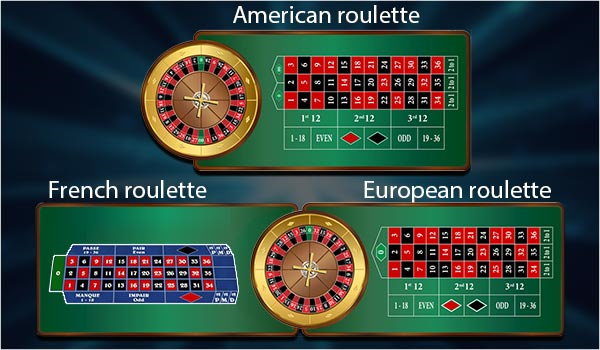Quote from
jeruweb3 on October 29, 2023, 2:31 pm
If you're interested in Roulette, you might have come across different variations of the game. Each version offers its unique twists and rules, making it essential to understand the differences. In this post, we'll delve into European, American, and French Roulette to see what sets them apart.

European Roulette: European Roulette is often considered the classic version of the game. It features a wheel with 37 pockets, numbered from 0 to 36. The key difference lies in the single zero (0) pocket, which gives players better odds compared to its American counterpart.
The presence of only one zero pocket in European Roulette results in a lower house edge, making it a more player-friendly option. When you make even-money bets (like red/black or odd/even), the "La Partage" or "En Prison" rules might apply in some variations, allowing you to recover half of your bet if the ball lands on the zero.
American Roulette: American Roulette is similar to European Roulette, with the addition of an extra double-zero (00) pocket. This brings the total number of pockets to 38. The extra zero increases the house edge, which can affect your odds of winning. The presence of the double zero makes American Roulette slightly more challenging for players, as it decreases the chances of winning when compared to European Roulette.
The "Surrender" rule in American Roulette is akin to the "La Partage" rule in European Roulette, allowing players to recoup a portion of their bets when the ball lands on zero or double zero.
French Roulette: French Roulette is a close cousin of European Roulette, and it offers some unique features that make it stand out. It also has a single zero pocket like European Roulette, but here's where it gets interesting:
-
"La Partage" Rule: In French Roulette, you have access to the "La Partage" rule, which means that if you place an even-money bet and the ball lands on zero, you'll receive half of your bet back.
-
"En Prison" Rule: French Roulette also offers the "En Prison" rule, which allows you to keep your even-money bet "in prison" for the next spin if the ball lands on zero. If your bet wins on the following spin, you get your original bet back. If it loses, you lose your bet.
Which One Should You Play? The choice of which Roulette variation to play depends on your preference and risk tolerance. If you prefer better odds and a lower house edge, European or French Roulette is the way to go. However, American Roulette can also be exciting if you enjoy a bit more challenge.
In conclusion, understanding the differences between European, American, and French Roulette is essential for making an informed choice when you step up to the Roulette table. Each version brings its own flavor to the game, so give them all a try and see which one suits your style and preferences the best. Happy spinning!
To Play Roulette games Check here
If you're interested in Roulette, you might have come across different variations of the game. Each version offers its unique twists and rules, making it essential to understand the differences. In this post, we'll delve into European, American, and French Roulette to see what sets them apart.

European Roulette: European Roulette is often considered the classic version of the game. It features a wheel with 37 pockets, numbered from 0 to 36. The key difference lies in the single zero (0) pocket, which gives players better odds compared to its American counterpart.
The presence of only one zero pocket in European Roulette results in a lower house edge, making it a more player-friendly option. When you make even-money bets (like red/black or odd/even), the "La Partage" or "En Prison" rules might apply in some variations, allowing you to recover half of your bet if the ball lands on the zero.
American Roulette: American Roulette is similar to European Roulette, with the addition of an extra double-zero (00) pocket. This brings the total number of pockets to 38. The extra zero increases the house edge, which can affect your odds of winning. The presence of the double zero makes American Roulette slightly more challenging for players, as it decreases the chances of winning when compared to European Roulette.
The "Surrender" rule in American Roulette is akin to the "La Partage" rule in European Roulette, allowing players to recoup a portion of their bets when the ball lands on zero or double zero.
French Roulette: French Roulette is a close cousin of European Roulette, and it offers some unique features that make it stand out. It also has a single zero pocket like European Roulette, but here's where it gets interesting:
-
"La Partage" Rule: In French Roulette, you have access to the "La Partage" rule, which means that if you place an even-money bet and the ball lands on zero, you'll receive half of your bet back.
-
"En Prison" Rule: French Roulette also offers the "En Prison" rule, which allows you to keep your even-money bet "in prison" for the next spin if the ball lands on zero. If your bet wins on the following spin, you get your original bet back. If it loses, you lose your bet.
Which One Should You Play? The choice of which Roulette variation to play depends on your preference and risk tolerance. If you prefer better odds and a lower house edge, European or French Roulette is the way to go. However, American Roulette can also be exciting if you enjoy a bit more challenge.
In conclusion, understanding the differences between European, American, and French Roulette is essential for making an informed choice when you step up to the Roulette table. Each version brings its own flavor to the game, so give them all a try and see which one suits your style and preferences the best. Happy spinning!
To Play Roulette games Check here









